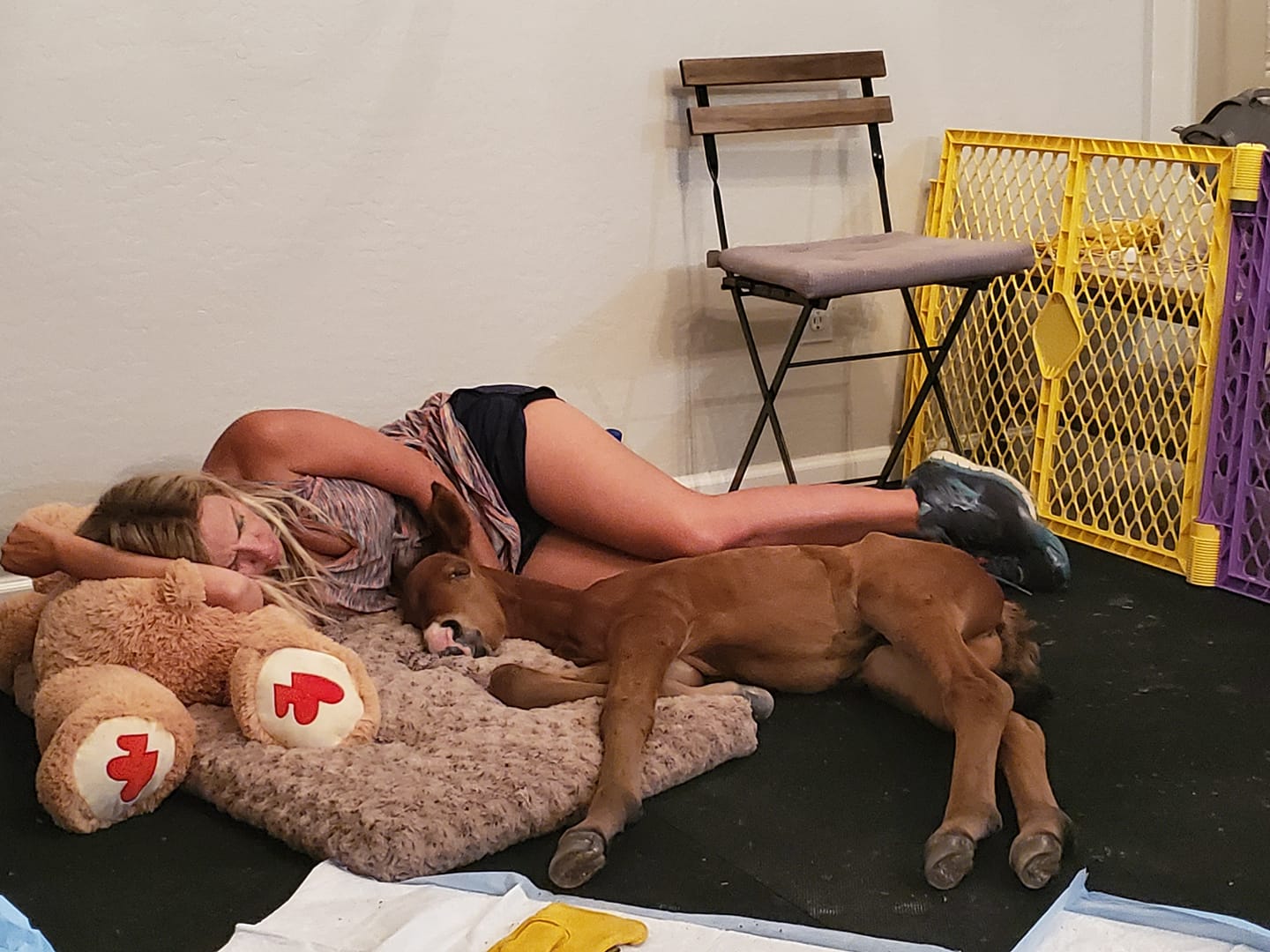
Lost/Abandoned Foal Policy (Update: We have another one!)
Hi everyone! We want to explain what our policy is on lost/abandoned foals, since we just ended up with yet another one!!
When we find a lost foal, or someone else finds a lost foal and calls us, we never just take it out of the forest right away.
Sometimes the mares are still closeby and they have simply lost eachother briefly, or sometimes they inadvertently are miles apart, but unless the mother is dead, they are still looking for eachother for at least 2 days, and can still be reunited.
This is why, we try to document births and new foals as soon as possible, so that when we find a foal, we know which mother and family band to go look for.
Foals can absolutely not survive without their mothers until they are about 3 to 4 months old. A newborn has in fact only 6 hrs time, to be rescued before it is not viable. Gideon is a good example of that and with some intensive effort, he made it! A foal of 5 weeks old, like Rosy, has a little longer, like a week, but after that week, she was in near fatal condition and it was a close call. With plasma, nutrition, surgery and supportive care, she now is also over the hump, and doing great!
(Naturally in the wild, foals will stay with their mothers and family bands, until they are approximately 2 years old. )
So, what do we do when you call us or mcso? (which we hope you will do, when you see a foal by itself). We will come immediately, to carefully examine the location, and find out which bands are in the area. We assess the condition of the foal (which can be done from a distance) and how much danger it is in. We then check if we have the foal logged in our database app, and if we do, we start looking for it’s matching band. (Still without capture of the foal).
If found, we then make a half circle around the matching band and we move them towards the foal, and at the same time, the second team will move the foal towards the band. This is a good hands off approach, if the foal is in good walking condition. We did a reuniting like this with a foal named Val a couple of years ago, and he is now a healthy stallion.
IF we are not successful in finding the band, and the foal is declining, we then capture the foal and put it in a temporary little pen in the forest and we feed it milk replacer, so that it doesn’t dehydrate. We still do not take the foal. During this time in the little pen, it can call out for it’s family and the mother gets a chance to find the foal while we make sure it stays in good condition.
One half of our team will be doing this for a couple of hours, while the other half of our team will still be looking for the band.
IF we find the band, and the foal is small enough, then we pick up the foal and walk it to where it’s band is. We then wait until foal and mother show signs of recognition, and when that happens, we set the foal down and retreat. We did this a couple of months ago, with the foal named Spring, and she is still growing up wild with her family.
We have done 3 reunitings this year and 6 reunitings total. It is a hallmark moment when that happens! We have never seen a mare or family band that did not want their foal back, when we brought it to them. They always show amazing joy and care, and there is basically a family celebration and greeting of the foal.
However, what to do, if it is a brand new foal and we have never seen it yet? In this case we start looking at all of the mares that were pregnant the day before, and were approximately due. This is a much more difficult situation, because there are a lot of options all of a sudden. At that point the location where the foal is, and to stay in that location becomes very important. Our team will be looking for any mare that has a full bag of milk, or even still a placenta or blood on her hind legs. We matched a newborn with its mother like this, this year also.
However yesterday, what happened is, we were alerted to two guys, who had taken a foal with them and were at the exit to the forest. We asked them where they found the foal and we received little information to go on. They were cooperative and surrendered the foal, but we had pretty much no clue as to what happened and no one had taken a picture of the horses that were around. We got two very different stories from different people, as to the intent, so it could have been good or bad, but we should not make assumptions. All we know is that we are likely not going to find out what happened.
Anyway, the moral of this story is, had they called SRWHMG, or MCSO when they saw the foal, it might have worked out a different way!
It is illegal to interact or take a Salt River horse, without written permission from the AZDA. Each time SRWHMG interacts or rescues a Salt River horse, we get that permission beforehand from our managing body, the AZDA.
So the situation was, we had to take the foal to make sure it survived and monitored and fed him overnight. After some investigating we found 4 possible options of mares who were due to give birth….we went searching for them today, and one of them was not pregnant anymore.
However, her reaction was not that of a searching mother, and we all had to get out of the 110 degree heat, so no success!
What can be the cause of these separations?
Well first of all we see it more, simply because we have more eyes and ears in the forest, we have you the public, and we have many many volunteers.
Second, it happens more because there are more horses; we have had a positive growth rate for many years, before we were allowed to start our humane birth control program.
Third, we believe that most foal separations are man-caused, but rarely ever on purpose, and most of the time the perpetrator completely unaware of the havoc they have caused.
There are many many people out in the forest, in fact many thousands per day, recreating in many different ways. Horse back riders, a loose dog, or even an innocent tuber can get several different bands in a commotion. If there happens to be a mom that just gave birth, then the foal is simply not fast enough yet to keep up. In other instances it can be a fence that inadvertently separates them, which is ultimately also man caused.
We hope this answers a lot of your questions and if you have any question at all ever, dont hesitate to ask here, simply on our Facebook page!
We need and love your support in order to take care of these babies and humanely manage the Salt River wild horses.
Please donate to their care if you possibly can. You make a difference! Www.srwhmg.org
